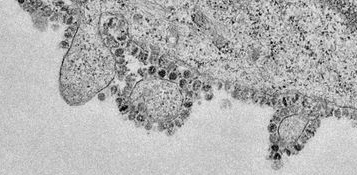Mutations: fear and real risk
2020/05/20 Galarraga Aiestaran, Ana - Elhuyar Zientzia Iturria: Elhuyar aldizkaria
Posted in Berria on 13 May 2020

Mutations are often considered terrifying or harmful. Once again, concerns have been raised about news about coronavirus mutations. In fact, in the UK press (The Guardian and Independent), it has been suggested that mutations that are suffering the virus will make it even more harmful, as they will help you expand. Reference is made to research conducted at the University of London, which has not yet been published. In addition, the researchers themselves have clarified that they do not know if the mutations they have identified will have consequences and that the virus is not moving especially quickly.
Again, the suggestion has caused some fear. However, according to Nature Microbiology, this fear is unfounded. This is what the title of an investigation has just published says: "We should not worry when a virus mutes into an outbreak."
The authors are researchers from the universities of Yale (USA) and Sydney (Australia), who have explained that mutations are part of the virus cycle and rarely significantly affect apparitions.
Along with this, they warn that distortion of mutation information can have terrible consequences. They have given as an example what happened with the Zika virus: A mutation on the surface of the virus was detected in 2018 before the virus caused a serious epidemic in America. Some researchers believe that this mutation was the cause of fetal microcephaly. Because when Zika arrived in India, they showed that the virus variant received there did not have that mutation. Therefore, they ruled out the risk of microcephaly. They were wrong.
The mutation is continued by the SARS-CoV-2 virus, changes occur each time your RNA is doubled. Thus, an infected person can have in the body, in a few hours, different versions of the same virus. Many of these mutations do not produce significant changes. Some are damaged by the virus and disappear spontaneously. In fact, evolution incites to endure the virus and not make it more harmful to us. If a mutation makes us more harmful but does not provide any advantage within the virus population, it will hardly prevail over other variants.
Moreover, when talking about mutations, the greatest fear arises from two possibilities: the increase of contagion and its perniciousness at the same time. But it is very difficult for the two to coincide. If the virus becomes very bad for the host, the contamination is normally reduced. In fact, if the host is very ill, he will not be in contact with other people, so the transmission of the virus will be reduced. The greatest risk of infection occurs when the virus is hidden, that is, when the incubation phase is long or does not produce symptoms. The latter has been one of the main reasons for the rapid and unforeseen spread of covid-19.
However, researchers have not underestimated the influence of mutations and recalled that SARS-CoV2 has come to us through mutations. Other examples are: aids-causing HIV also comes from a chimpanzee virus; and the Ebola virus also causes the lethal capacity for human infection to mutate. But they stressed that it is impossible to foresee and demonstrate the influence of mutations at the center of the appearance. For this it takes time and has still been a short time.
That is: Thanks to the identification of SARS-CoV-2 mutations, researchers have developed a phylogenetic tree of the virus that has allowed them to follow the deployment of the pandemic. They warn that forecasts that go beyond can be wrong and even dangerous.

Gai honi buruzko eduki gehiago
Elhuyarrek garatutako teknologia




.jpg)
